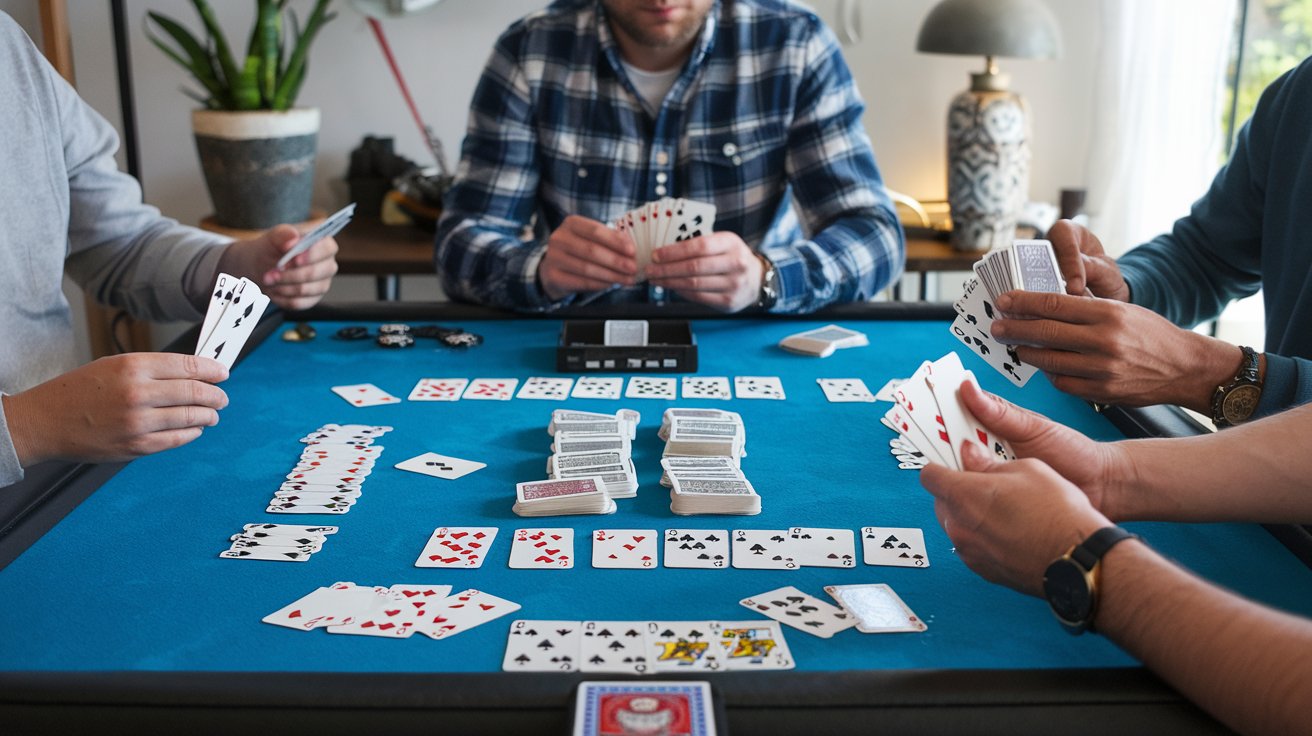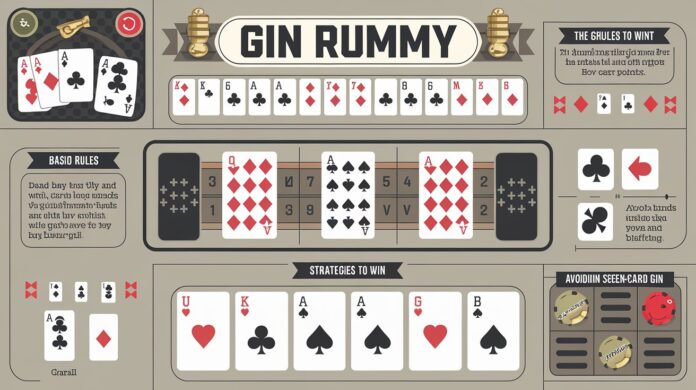Gin Rummy is one of the most popular and widely played card games across the world. It’s a two-player version of the traditional Rummy game, and its simplicity and strategic depth make it a favorite among card enthusiasts. Whether you’re a seasoned player or a beginner, understanding the rules and strategies behind Gin Rummy can elevate your game and increase your chances of winning.
In this comprehensive guide, we’ll dive deep into what Gin Rummy is, explain the rules of the game, and share effective strategies that will help you become a Gin Rummy expert. Let’s get started!
What Is Gin Rummy?

Gin Rummy is a two-player card game that is a variant of the classic Rummy. The objective of Gin Rummy is to form sets and runs using the 10 cards dealt to you. A set consists of three or four cards of the same rank but from different suits (e.g., 7 of Hearts, 7 of Spades, and 7 of Diamonds), while a run is a sequence of three or more consecutive cards from the same suit (e.g., 4, 5, 6 of Diamonds).
Unlike traditional Rummy, which is played with a larger group, Gin Rummy is fast-paced, typically lasting only 10-20 minutes per game. It’s popular for its strategic gameplay and quick decision-making. The game is usually played to a set score, often 100 points or more.
How to Play Gin Rummy: Rules and Setup
To begin playing Gin Rummy, it’s essential to understand the game rules, which are relatively simple but involve a good deal of strategy. Here’s how to play Gin Rummy step by step:
1. The Deal
- Number of Players: Gin Rummy is played between two players.
- Deck of Cards: A standard 52-card deck is used.
- Dealing the Cards: The dealer shuffles the deck and deals 10 cards to each player. The remaining deck is placed face-down in the center to form the stockpile, and the top card from the stockpile is placed face-up next to it to start the discard pile.
2. Objective of the Game
The main goal of Gin Rummy is to meld all of your cards into valid sets and runs, leaving you with as few leftover cards as possible. Once you’ve arranged your cards into sets and runs, you can “knock” and declare the end of the round. To go out or “knock,” you must have fewer than 10 points left in your hand. Points are awarded based on the cards left in your opponent’s hand.
3. Gameplay Flow
The gameplay alternates between the two players, with each player taking turns to either draw a card or discard a card:
- Drawing: On a player’s turn, they can choose to either draw a card from the stockpile or pick the top card from the discard pile.
- Melding: After drawing a card, players can try to form sets and runs with the cards in their hand. You don’t have to lay your cards down unless you “knock.”
- Discarding: At the end of their turn, a player must discard one card onto the discard pile.
4. Knocking
In Gin Rummy, you can choose to knock when the value of your unmatched cards (or “deadwood”) is less than 10 points. Knocking signals the end of the round. When you knock, you lay down your melded sets and runs, and your opponent lays down their cards as well. The round ends with the following steps:
- If you have less deadwood, you win the round.
- If your opponent has less deadwood, they win the round.
5. Scoring in Gin Rummy
The winner of the round earns points based on the remaining cards in the opponent’s hand. Here’s how scoring works:
- Deadwood: Cards that don’t form a set or run are considered deadwood. For each card in your opponent’s hand that isn’t part of a valid set or run, they lose points.
- Gin: If you manage to form valid sets and runs with all your cards and don’t have any deadwood, you’ve gone Gin and score an additional 25 points.
- Knock: If you knock but have deadwood left, you only score the difference between your deadwood and your opponent’s deadwood.
Winning a Game of Gin Rummy

A game of Gin Rummy is typically played until one player reaches a pre-determined score, usually 100 points or more. A player can win a round by knocking with fewer than 10 points in deadwood, or by going Gin with no deadwood at all. The winner of the round adds the points to their total, and the game continues until the target score is reached.
Strategies to Win at Gin Rummy
While luck plays a role in Rummy, strategy is the key to mastering the game and winning consistently. Here are some effective strategies that can improve your chances of winning at Gin Rummy:
1. Form Sets and Runs Quickly
As a beginner, your first goal should be to form sets and runs as quickly as possible. The faster you can organize your hand, the less deadwood you’ll have, and the sooner you can knock or go Gin. A good strategy is to focus on building your hand in the early game, even if that means discarding cards that aren’t useful.
Pro Tip: Prioritize runs (sequences of cards in the same suit) because they’re harder for your opponent to break apart.
2. Don’t Hold onto High-Value Cards
In Gin Rummy, face cards (Jack, Queen, King) and Aces are worth 10 points each. Holding onto high-value cards increases the likelihood of having a high deadwood total at the end of the round. Instead, try to meld these cards into valid sets or runs as soon as possible.
Pro Tip: If you can’t use high-value cards in sets or runs, it’s better to discard them early rather than risk holding onto them.
3. Pay Attention to the Discard Pile
In Gin Rummy, the discard pile is just as important as your hand. Observing your opponent’s discards can give you valuable information about the cards they’re trying to collect. If your opponent discards a card, it means they no longer need it. You can use this information to either draw from the stockpile or discard a card that your opponent is likely to need.
Pro Tip: Avoid discarding cards that could complete a set or run for your opponent. For example, if you see your opponent discarding a 7 of Spades, be cautious before discarding a 7 of Clubs, as it may help them complete a run.
4. Knock When You Can
If you have less than 10 points in deadwood and your opponent hasn’t gone Gin yet, knocking is a smart move to end the round. However, don’t knock too early if you think your opponent might have fewer points in their hand. Ideally, you want to wait until you have a solid combination of cards and don’t risk being caught with too many points in your hand.
Pro Tip: Only knock when you feel you’re in a favorable position. If your opponent is likely to have low deadwood, it’s better to hold off and continue improving your hand.
5. Watch for Opportunities to Go Gin
Going Gin is the ultimate goal in Gin Rummy, as it scores you 25 extra points. To go Gin, you need to form valid sets and runs with all 10 of your cards and have no deadwood left. As you play more, you’ll start to recognize opportunities where going Gin is possible. If you’re in a good position, and your hand is coming together nicely, don’t hesitate to go Gin.
Pro Tip: If you’re close to going Gin and you have several low-value cards in your hand, it’s often worth holding onto them rather than knocking early.
6. Manage Your Deadwood
One of the most important aspects of Gin Rummy is managing your deadwood. As the game progresses, focus on getting rid of your deadwood, whether by forming sets and runs or by discarding cards that don’t fit into your current strategy. By keeping your deadwood low, you reduce your opponent’s chances of winning when they knock.
Pro Tip: Don’t be afraid to discard cards that are unlikely to form sets or runs. The sooner you get rid of excess cards, the better your chances of knocking or going Gin.
Common Mistakes to Avoid in Gin Rummy

Even seasoned players can make mistakes, but being aware of common blunders can help you avoid them:
- Overhanging on High-Value Cards: Holding onto face cards or Aces too long can leave you vulnerable to having too many points if the game ends early.
- Knocking Too Early: It’s tempting to knock early if you have low deadwood, but if your opponent is close to going Gin, you might want to hold off.
- Ignoring the Discard Pile: Not paying attention to the discard pile can prevent you from gathering valuable information about your opponent’s hand.
- Discarding Useful Cards: Don’t discard cards that could help you form sets or runs. Hold onto useful cards as long as possible.
Conclusion
Gin Rummy is a fun and fast-paced game that requires both strategy and skill. Understanding the rules and following effective strategies can greatly improve your chances of winning. Whether you’re playing casually with friends or in a competitive setting, mastering Gin Rummy involves a combination of quick thinking, strategic discards, and careful hand management.
By focusing on forming sets and runs early, paying attention to the discard pile, and managing your deadwood, you’ll be well on your way to becoming a Gin Rummy expert. Practice regularly, and soon you’ll be able to outwit your opponents and declare Gin with confidence!
So, gather a deck of cards, invite a friend, and put these tips into practice the next time you play Gin Rummy. The thrill of mastering this game is just a card away!

Zareb Saleh is a journalist at Gulf Today and a ghostwriter for Gameoholic, specializing in gaming, technology, and digital culture. With a keen eye for industry trends, he delivers insightful stories that engage and inform readers.




